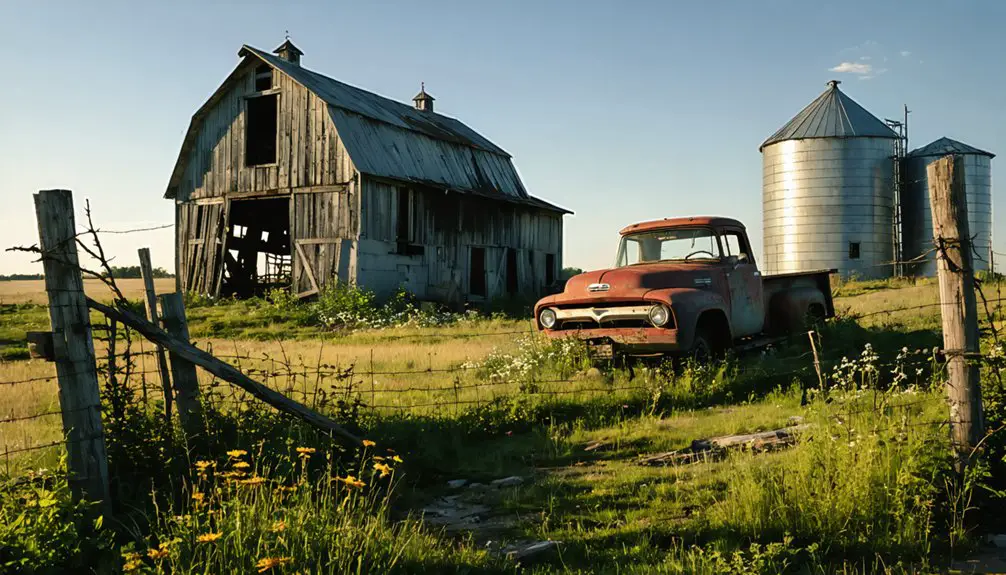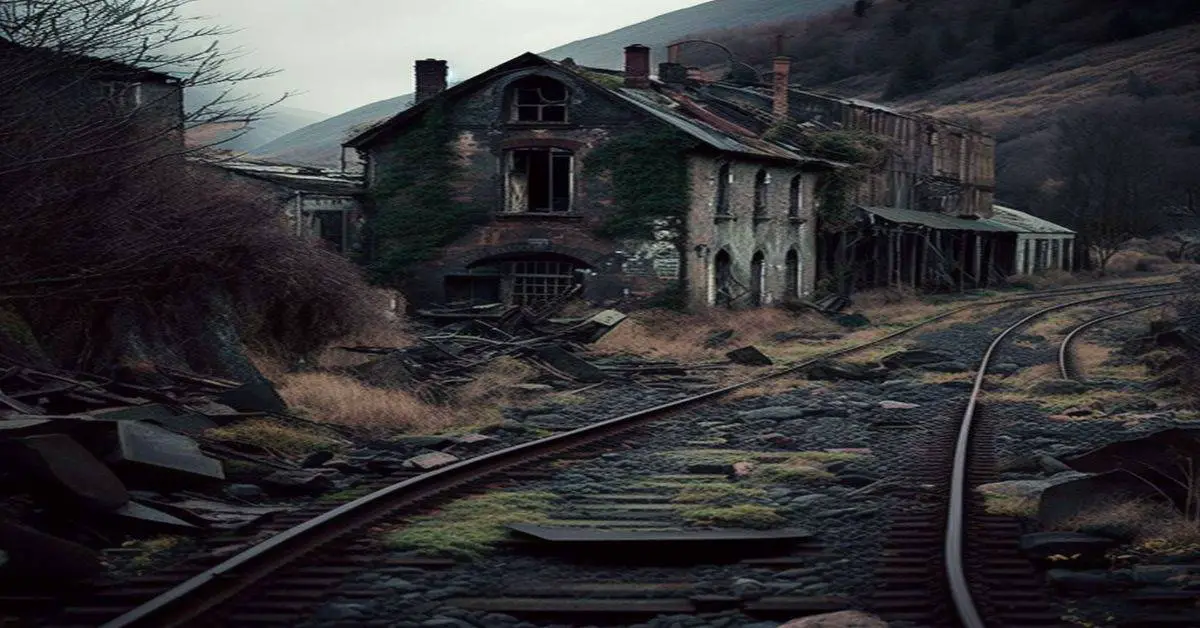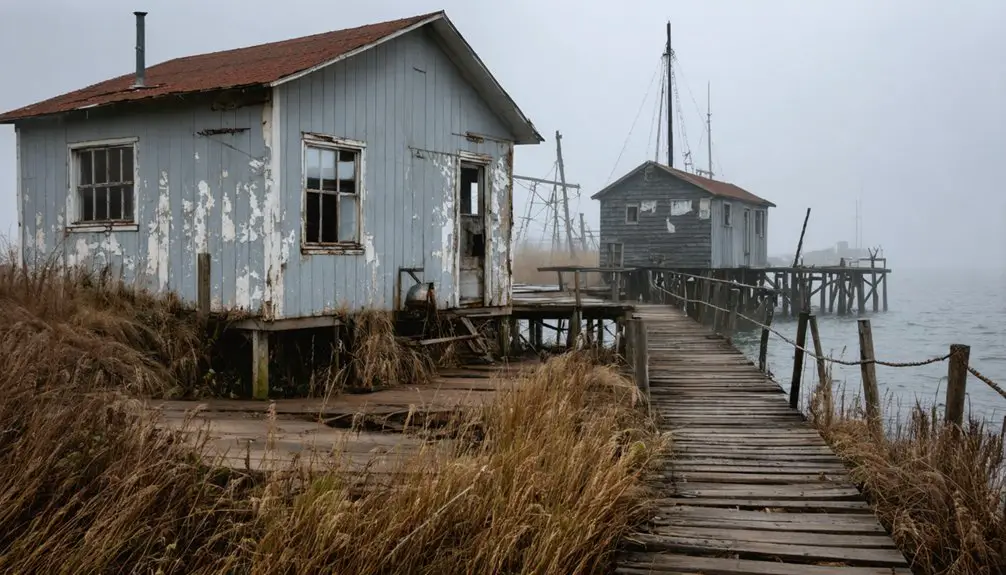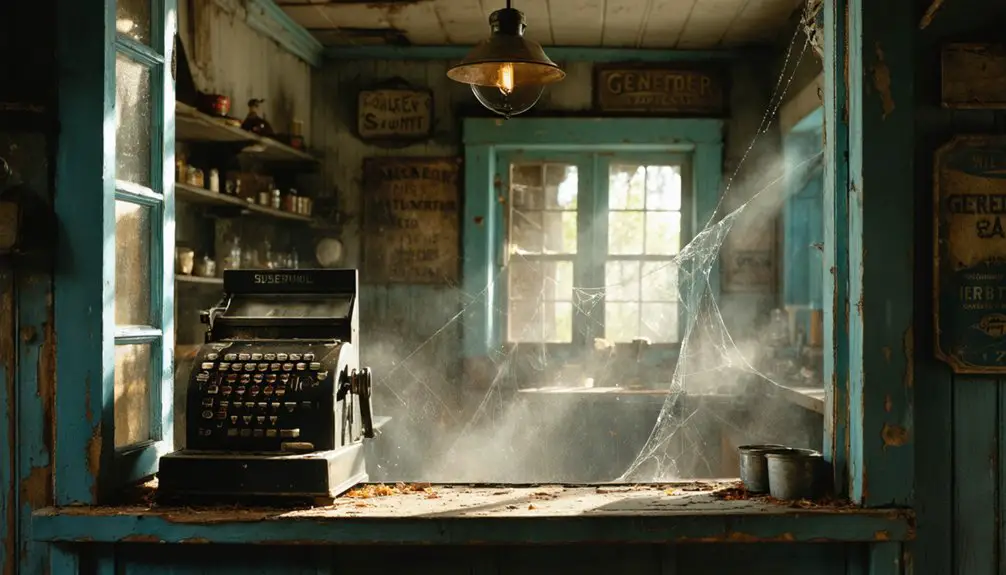You’ll find Stettin nestled in Marathon County‘s diverse terrain, established in 1860 between Wausau and the Clark County line. This former lumber town thrived on three major industries: timber processing, agriculture, and granite quarrying. Under Charles Buttke’s leadership as first chairman, the community supported seven school districts and multiple cheese factories. Though timber depletion led to its decline, Stettin’s rich history lives on through extensive archives and preserved records that reveal a fascinating story of boom-and-bust Wisconsin.
Key Takeaways
- Stettin was established in 1860 in Marathon County, Wisconsin, initially thriving through lumber processing, agriculture, and granite quarrying industries.
- The town’s economic decline began in the late 1800s when timber resources were depleted, causing sawmills to close and workers to leave.
- Multiple cheese factories, taverns, and roadhouses once served as social hubs before the town’s population decreased significantly.
- Early sawmills produced 40,000 board feet of lumber per day and employed 35 men by 1881.
- The Marathon County Historical Society maintains extensive records of Stettin’s history through census data, plat maps, and oral histories.
Origins and Early Settlement
While Wisconsin was still emerging from its territorial period, the Town of Stettin took shape in Marathon County‘s dense wilderness. In February 1860, the County Board officially established Stettin, encompassing township 29, ranges 2 to 6 east. Judge Louis Marchetti highlighted Stettin’s rise to become one of the richest towns in the county.
You’ll find the settler motivations were clear – the Buttke brothers and their cousins led the charge, driven by opportunities in farming and logging.
These pioneering families faced brutal challenges, clearing thick forests while developing agricultural practices suited to the harsh environment. They carved out homesteads from Wausau to the Trappe River, with Charles Buttke emerging as the town’s first chairman in that spring’s election.
Despite the difficulties of Marshall Hill’s steep terrain and punishing winters, these determined settlers laid the foundation for Stettin’s early economy through farming and lumbering. The area would later support seven school districts, each providing education in modern schoolhouses.
Native American Relations and Conflicts
Before settlers established Stettin, the region had already witnessed significant Native American conflicts that shaped its development. The Black Hawk War of 1832 and Winnebago War of 1827 brought intense Native resistance and military responses near the future ghost town’s location, fundamentally altering tribal alliances and settler expansion patterns. Indian Removal Act forced massive tribal displacements through Wisconsin Territory in the 1830s. The British Band’s fierce resistance to American expansion led to clashes with squatters when Black Hawk returned to Saukenuk in 1829.
- Black Hawk’s crossing into the Wisconsin River Valley sparked conflicts that reached Stettin’s future territory.
- Potawatomi tribes sought neutrality while facing pressure from both settlers and other Native groups.
- Ho-Chunk leaders struggled with internal divisions during the Winnebago War.
- The Bad Axe Massacre devastated Native communities and accelerated forced relocations.
- Cultural impact of these conflicts created lasting tensions between settlers and remaining tribal members around Stettin.
Geographic Features and Boundaries
You’ll find the ghost town of Stettin nestled within the varied terrain of Marathon County, where the 36.6-square-mile township retains only a fraction of its original 1860 boundaries that once stretched from Wausau to the Clark County line.
The name Stettin comes from the major Baltic seaport in Poland, reflecting the German heritage of early settlers. The landscape features minimal water coverage, with only 0.52% of the total area comprising waterways, while the remaining 36.4 square miles consist of rural and partly wooded settings. Today, the area maintains 72 miles of public roads throughout its territory.
The town’s natural geography played a vital role in early development, with features like the nearby Big Bull Falls influencing transportation routes and lumber activities in the region.
River Valley Landscape Features
The steep-sided valleys and eroded ridges surrounding Stettin, Wisconsin showcase the region’s unglaciated terrain, characterized by exposed Paleozoic bedrock and ancient river systems.
You’ll find complex river morphology shaped by the Wisconsin River, which carved deep valleys filled with glacial deposits. The Laurentide Ice Sheet retreating northward helped establish the river’s major drainage patterns. The floodplain complexity creates a diverse landscape of terraces and microhabitats. The area shares characteristics with the Western Upland region, featuring dramatic bluffs and forested valleys.
- Exposed cliffs and talus slopes dominate the valley walls
- Ancient sand dunes rest on broad river terraces
- Multiple sand-and-gravel terraces mark historic flood levels
- Windblown loess and alluvial deposits form varied soil layers
- High-gradient headwater streams reflect the rugged topography
The westward-flowing river valley features a deeply scoured bedrock floor, while steep ridges direct tributary patterns, creating a dynamic watershed system that’s remained largely untouched by recent glaciation.
Township Border Evolution
Since its establishment by the Marathon County Board in February 1860, Stettin Township‘s borders have undergone dramatic transformations from its original vast expanse.
You’ll find that the township initially stretched from near Wausau to the Clark County line, encompassing what would later become Rib Falls, Rietbrock, Johnson, and Holton townships. These extensive boundaries didn’t last long, as settlement patterns quickly demanded more localized administration.
The Wisconsin River played a vital role in boundary adjustments, creating natural divisions that influenced how borders were drawn. When Town of Hull was established in 1873, it further redefined the regional boundaries of surrounding townships. The comprehensive 62 pages of historical records document these significant boundary changes over time.
You’ll notice that early transportation routes, particularly the trail to Big Bull Falls, shaped settlement clusters. As railroads arrived in the 1870s, they further influenced the township’s evolving borders, leading to the more compact, manageable boundaries you see today.
Economic Activities and Industries
During its heyday, Stettin emerged as a significant economic hub in Marathon County, with three major industries driving its growth: lumber processing, agriculture, and granite quarrying.
You’ll find the town’s early prosperity reflected in its bustling sawmills, which produced an impressive 40,000 board feet of lumber per 12-hour workday.
- One of Marathon County’s first sawmills operated here, employing 35 men by 1881.
- The town’s granite quarries, started by Grothe & Peters, grew to employ 75 workers.
- Local dairy farms supplied multiple cheese factories, boosting Wisconsin’s reputation.
- The first farm in Marathon County was established in Stettin’s fertile soil.
- Custom sawmills and portable mills served farmers for generations.
Despite uranium exploration in 1946, Stettin’s economy remained firmly rooted in lumber production, farming, and granite quarrying throughout its prime years.
Social Life and Community Establishments
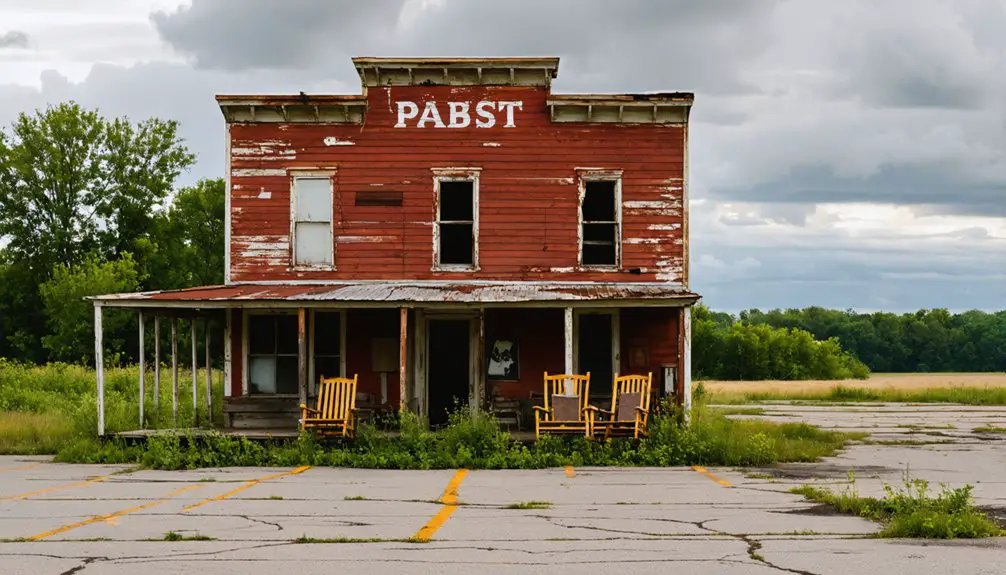
While Stettin’s economic foundations rested on its industries, social life flourished through a network of community establishments scattered across Marathon County.
You’d find locals gathering at Ringle’s Hall for civic discussions and community festivals that marked the changing agricultural seasons. The area’s cheese factories, taverns, and roadhouses served as essential social hubs where you could catch up on news and strengthen bonds with neighbors.
Local churches and schools brought families together, while outdoor activities like fishing and hunting connected you to the surrounding wilderness.
Though tensions occasionally flared between settlers and indigenous peoples during the 1860s, particularly during the Sioux War, the community maintained its cohesion through shared traditions, harvest celebrations, and cooperative work projects that defined life in this rural settlement.
The Decline and Abandonment
As timber resources vanished from Marathon County’s forests in the late 1800s, Stettin’s economic foundations began to crumble.
You’ll find Stettin among Wisconsin’s ghost towns today, a casualty of rural migration and changing economic tides. The transformation from bustling lumber town to abandoned settlement happened through a cascade of losses:
- Sawmills shut down as timber depleted, forcing workers to seek jobs in the Dakotas, Nebraska, and Oregon
- Family farms got swallowed up by large agricultural conglomerates
- Essential businesses and services vanished as population dwindled
- Infrastructure deteriorated with no one left to maintain it
- Community spirit faded as neighbors departed one by one
The town’s decline mirrors many rural Wisconsin communities that couldn’t adapt when their primary industry collapsed, leaving behind empty buildings and quiet streets.
Historical Records and Preservation
You’ll find extensive documentation of Stettin’s history through Marathon County Historical Society’s digitized census records and city directories dating from 1850 to 2010.
The collection includes detailed plat maps and land ownership records that track the township’s development from its early sawmill operations in 1844 through its gradual decline.
Family researchers can access volunteer-transcribed databases of resident names, military records, and oral histories preserved in the 1860-1960 Stettin Centennial Booklet at regional historical libraries.
Census and Land Documents
Since 1820, Marathon County has maintained extensive census records that chronicle Stettin’s demographic evolution, with land documentation beginning around 1850.
You’ll find census trends revealing the area’s growth from just 508 residents in 1850 to over 134,000 by 2010, while tracking Stettin’s transformation into its current ghost town status.
- Marathon County’s plat maps from 1882-1905 detail property boundaries and township layouts
- Over 250,000 indexed records document land ownership patterns and population shifts
- Military censuses from 1890-1905 track veteran demographics in Stettin
- Probate records since 1900 reveal land transactions and inheritance patterns
- Town histories and centennial publications provide context for Stettin’s development
These preserved documents let you trace Stettin’s evolution from settlement through abandonment, offering insights into the community’s rise and decline.
Archive Collection Accessibility
While Marathon County Historical Society maintains extensive physical archives, researchers can now access over 250,000 indexed records through their digital database.
You’ll find searchable census data from 1850-1930, along with city directories spanning 1897-2010 that cover Stettin and surrounding towns.
The digital archives offer name-based searches to track Stettin’s development, though you’ll need to visit physical repositories for certain materials like plat maps and early industrial records.
Through community engagement, volunteers continue expanding the online collection by transcribing and indexing historical documents.
However, you should note that some ghost town records remain fragmented or missing, and volunteer-submitted data may require cross-verification with published sources.
The Historical Society’s partnerships with state archives guarantee ongoing preservation of Marathon County’s history.
Family History Record Sources
Tracing family histories in Stettin benefits from Marathon County’s well-preserved collection of records dating back to the mid-1800s.
If you’re building your family tree, you’ll find extensive documentation through crucial records, land transactions, and census data that illuminate your ancestors’ lives in this Wisconsin community.
- Birth, marriage, and death records from 1900 onward provide essential genealogy research foundations
- Land records since 1850 reveal property ownership and settlement patterns
- The Stettin Centennial Booklet (1860-1960) offers rich context about early settler families
- City directories from 1897-2010 track residents’ occupations and movements
- Cross-referenced census records from 1850-1930 show household compositions and demographics
These preserved documents paint a detailed picture of family histories, making it possible to reconstruct genealogical connections even when traditional crucial records are incomplete.
Frequently Asked Questions
Are There Any Remaining Original Structures Still Standing in Stettin Today?
You won’t find any original buildings from Stettin’s pioneer days still standing, as historic preservation records don’t show surviving structures. The town’s evolved into modern suburban development without preserving early architecture.
What Happened to the Families Who Lived in Stettin After Abandonment?
You’ll find most Stettin families moved to Marathon and Wausau for better jobs, while keeping their cultural ties. Their Stettin legacy lived on through reunions, traditions, and local business ventures.
Were There Any Notable Crimes or Mysteries Associated With Stettin?
Like a blank page in history’s book, you won’t find unsolved mysteries or historical crimes tied to this settlement – there’s no documented evidence of major criminal activity in Stettin’s past.
Can Visitors Access the Former Town Site of Stettin?
You’ll face access restrictions since the former town site sits on what’s likely private property. There’s no dedicated visitor experience – you’ll need landowner permission to explore the area legally.
Did Any Famous People or Events Originate From Stettin?
Like pioneers blazing a trail, you’ll find Charles Buttke, the town’s first chairman, among its most notable residents. The 1862 Sioux War scare and local militia events shaped Stettin’s history.
References
- http://genealogytrails.com/wis/marathon/history/history_stettincentennial.html
- http://genealogytrails.com/wis/marathon/history/history_towns2.html
- https://en.wikipedia.org/wiki/List_of_ghost_towns_in_Wisconsin
- https://www.mindat.org/feature-5274626.html
- https://marathoncountyhistory.org/main-menu/our-history-online
- http://genealogytrails.com/wis/marathon/history/history_towns3.html
- https://asset.library.wisc.edu/1711.dl/XCYPJBMQ7ACE68O/E/file-17b1b.pdf?dl
- https://www.familysearch.org/en/wiki/Marathon_County
- https://www.youtube.com/watch?v=B6cJ7oxzObU
- https://en.wikipedia.org/wiki/Black_Hawk_War
